Philippine Churches: A journey of discovery
One of the highlights of my recent visit to the Philippines was discovering the country’s beautiful old churches.
I have not long returned from the Philippines; my third visit to this beautiful country. I want to share my experience of visiting some of the most ancient churches in the Philippines.
The Philippines is one of only two predominantly Christian countries in Asia (the other being East Timor). The faith was introduced by the Spaniards when they colonised the country in 1565.
From the very beginning, church construction was a priority. As a result, the Philippines is fortunate to have many beautiful and historic churches across its various provinces and cities. Here are some of the highlights of my recent visit:
St William’s Cathedral, Laoag
My first stop from Manila was the city of Laoag (la-wag), in the province of Ilocos Norte. Ilocos is in the northern part of the country, approximately 400 km from Manila. The most famous historic building in Laoag is St. William’s Cathedral.

The exterior of St Williams Metropolitan Cathedral in Laoag.
The original church was constructed in around 1661, but following an earthquake and a fire, the church had to be restored in 1843. This church is notable for two reasons; it has a most unusual façade which features pots and pilasters, and it has a sinking bell tower located a massive 80 metres from the church (I had to cross the road and a car park to reach it).
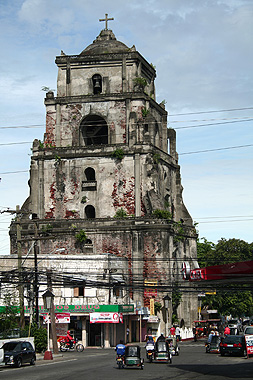
The monolithic old bell tower in Laoag, Ilocos Norte
The Philippines has historically been somewhat prone to earthquakes, and the Spanish quickly learnt that it was best to build belfries separate from the church to protect both structures.
As a result, the bell tower in Laoag is massive. And because of an earthquake in 1953, the tower has been sinking at a rate of 2.5cm a year. Folklore states that a man on horseback could once ride under the entrance arch, but now a man has to stoop in order to fit under the entrance arch. I happen to know this because I was lucky enough to gain special access to the bell tower.
Climbing the bell tower was quite an ordeal. The steps were uneven, the roof was very low and there was almost no light whatsoever. My tour guide disturbed a bat on our way up, which in a panicked state flew into his face!
We eventually made it to the top and the view was truly worth it . I was able to see across the entire city of Laoag. There were three giant bells in the tower, but I resisted the urge to ring one of them!
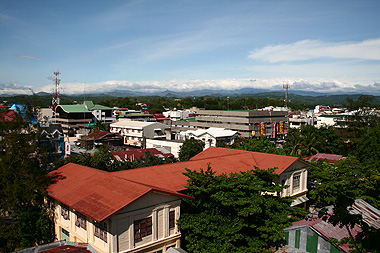
The view from the top of the bell tower, across the city of Laoag
St Paul’s Cathedral, Vigan
From Laoag, I travelled south to the town of Vigan, in the province of Ilocos Sur. Vigan is the best surviving example of a planned Spanish town in Asia, and has been added to the UNESCO World Heritage Register in recognition of its world heritage significance.
Unlike most Philippine cities, Vigan managed to escape the ravages of World War II and is just a sample of what most of the Philippines would once have looked like. Since this blog post is about heritage Philippine churches, I’ll save my description of the beautiful heritage city of Vigan for another post and just focus on St Paul’s Church in the heart of Vigan.
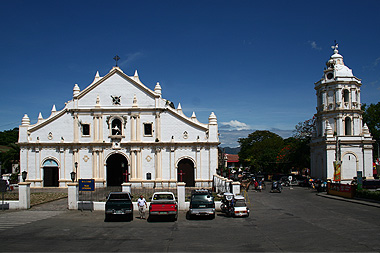
St Paul’s Cathedral and Bell Tower in Vigan, Ilocos Sur
The first church was constructed in Vigan in 1574, but as was typical for the Philippines this, and several replacement churches, were destroyed by various earthquakes. The current church was constructed in 1790-1800 and is certainly one of the most picturesque that I saw in the Philippines. The bell tower stands on the other side of the road from the church. St Paul’s Cathedral is well-maintained and has a truly beautiful interior to match its grand façade.
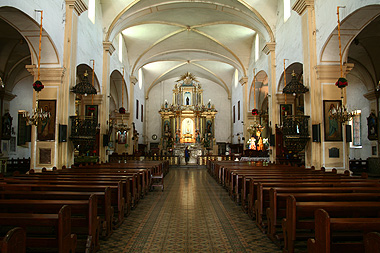
The interior of St Paul’s Cathedral in Vigan, Ilocos Sur
San Agustin Church, Paoay
In between Vigan and Laoag are many more heritage Ilocano churches, but by far the most famous and indeed my favourite was the Church of San Agustin in Paoay (pa-why), better known as the Paoay Church.

The famous Paoay Church, which is listed on the UNESCO World Heritage Register
This amazing structure was constructed in 1699 and appears on the UNESCO World Heritage List. Its design style is described as “Earthquake Baroque“; a reference to its Baroque architectural influences, but with the addition of ultra-wide buttresses to protect the building from earthquakes.
It is those buttresses, with their scrolled motifs, that give the building its “fat” appearance. I was astounded at the sheer size of the buttresses which were more than 3 metres thick and extending a massive 4 metres from the walls, which themselves are 1.7 metres thick.

Giant buttresses support the walls of the Paoay Church
Equally as interesting as those buttresses is the very material from which they are constructed. Rather than using stone, the Paoay Church builders chose to use coral blocks as the primary building material. Coral is strong, but much lighter than stone and therefore construction is much easier. The coral was quarried from the nearby South China Sea and is held together with mortar. A close inspection of the walls where the render has fallen away shows the intricate coral details on each chiselled block.
Whilst the Paoay Church is spectacular on the outside, it is not nearly so impressive on the inside. The ceiling was once painted with a scene similar to that of the Sistine Chapel in Italy, but owing to earthquake damage was long ago destroyed. Today the ceiling consists of rows of steel trusses with corrugated iron above. Nevertheless, this is a very special place to visit.
Bohol Churches
If it’s a church interior that one is interested in, then I highly recommend a visit to the parish of Nuestra Señora de la Luz (Our Lady of Light) in Loon (lo-on), Bohol.
Bohol is an island in the Visayas, an island group in the middle of the Philippines. Whilst Bohol is most recognised for its wildlife and beaches, it hosts several heritage churches, of which Nuestra Señora de la Luz is one. Constructed in 1862, this church is elegant on the outside. But inside, it’s nave is filled with beautiful detailed paintings on the ceiling.
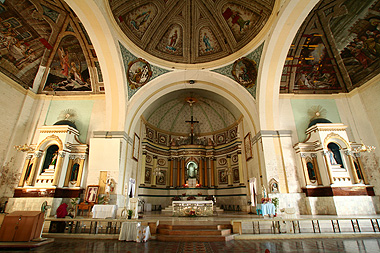
Nuestra Señora de la Luz in Loon, Bohol
Despite the beauty of Nuestra Señora de la Luz in Loon, my favourite church interior was that of the Immaculada Concepcion de la Virgen Maria (Immaculate Conception of Virgin Mary) church in Baclayon, also on Bohol Island.
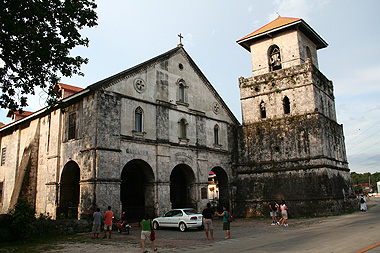
Immaculada Concepcion de la Virgen Maria in Baclayon, Bohol.
Built in 1595, Immaculada Concepcion de la Virgen Maria is one of the oldest churches in the Philippines. The relatively ordinary Romanesque exterior conceals the beautifully-designed interior which features arched ceilings, Corinthian columns and a beautifully-sculptured altar in the rococo style. Most importantly, this church is skilfully illuminated from the inside to highlight the decorative elements of the interior. By far, this was my favourite Philippine church interior.

Interior of the Immaculada Concepcion de la Virgen Maria in Baclayon
Basílica Minore del Santo Niño de Cebú
The last great Philippine church that I wish to mention is in fact a minor basilica. The Basílica Minore del Santo Niño de Cebú (Minor Basilica of the Holy Child of Cebu) was constructed in 1732 following the destruction by earthquake of the previous buildings. This church is significant because it effectively represents the birthplace of Christianity in the Philippines. Cebu was the first Spanish settlement on the islands and it was from here that evangelisation started. The church hosts Magellan’s Cross, a historic relic.
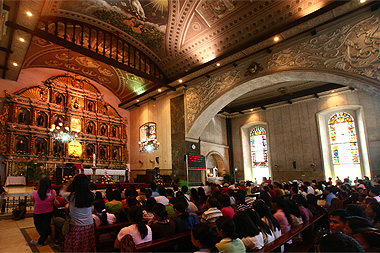
Interior of the Basílica Minore del Santo Niño de Cebú
Ferdinand Magellan was the first European to come to the Philippines in 1521. When he and his crews landed on Cebu island, a native chief, Rajah Humabon, met and befriended him. Rajah Humabon, his wife and hundreds of his native warriors agreed to accept Christianity and were consequently baptised. Magellan planted a cross to signify the introduction of the Christian faith in Cebu.
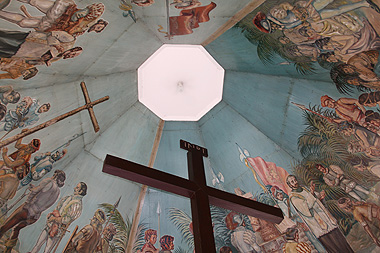
Magellan’s Cross
Aside from the historic cross, the church itself is an elegant building with a beautiful bell tower on its front and an attractive interior.
The Philippines is full of many beautiful, old and historic ecclesiastic buildings. As an Australian, I was fascinated to visit churches that were erected more than 200 years before my country was even settled!
The Church in Philippine Society
The method of construction using the “Earthquake Baroque” style or variants thereof, tell the story of a nation that seriously valued (and values) the presence of the local church. It is no coincidence that the churches have become the most enduring architectural structures in the Philippines, much as they have in Australia. What a society values the most, it will do the most to protect.
The churches in the Philippines were not just places of worship during the Spanish colonial period. Nor were they mere symbols of the authority of the Spanish Crown or the Catholic clergy. They have also became much-loved symbols of Filipino cultural identity, which persists to this very day.
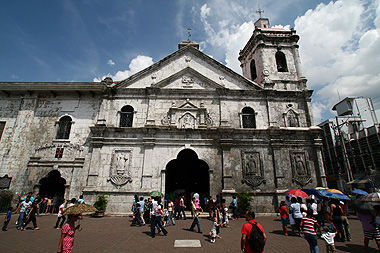
One of the interesting cultural aspects of the Philippine churches is the double-use of the bell towers. Their primary function was to host the bells, but they had an important secondary function as watch towers.
In the sixteenth century, there were two threats. On land, the Spanish faced opposition from some Filipinos who objected to Christianisation and colonial rule. At sea, there was a threat that other European powers might seize the Philippines. Therefore the bell tower doubled as a watch tower in many places, so the Spanish could prepare for any attacks.
It is ironic that the roles were reversed in the 1890’s when the Filipinos were fighting the Spanish for their freedom and independence. One of the many reasons the Filipinos wanted independence was to allow native-born Filipinos (as opposed to insulares, mestizos or Spaniards) to be ordained into the Catholic Church.
During the Spanish-Philippine war, the bell towers were utilised by the katipuneros to keep an eye out for the Spanish Army which sought to quell the rebellion. The same technique was used again when the Filipinos unsuccessfully tried to prevent the Philippines becoming a colony of the United States in 1901.
Given this colourful history, the historic churches in the Philippines are more than just significant architectural treasures, or places of contemporary worship. They are tangible and important symbols of Filipino culture and tell the story of a nation.
Visiting these places was fascinating on so many levels, and I am really pleased that I was able to see these amazing historical sites for myself.
Comments
20 responses to “Philippine Churches: A journey of discovery”
Adam, your journey of discovery is an absorbing read. You really are able to make your “blog” both informative and interesting. Your trip must have been such a pleasure for you.Those historic churches are so old and so beautiful inside. The bell tower story is especially interesting.
Thanks for sharing some fascinating religious structures in your great pictures and detailed descriptions. Churches the like of which i never knew existed and some constructed from coral… madness
Adam, thank you so much for talking about our churches. They are truly one of the most important treasures of our people. I do hope you could come back again some day and see more wonderful and amazing monuments to our faith. God bless you.
hi, adam! i enjoyed reading this post because i love old churches. have you been to iloilo? visit miag-ao church. churches in batanes are also interesting and beautiful. 🙂
Since you’ve been to Cebu, Philippines, have you visited the Churches in the south? Hope you’ll be able to, they are great treasures as well. The sad thing is that one of the old church and its convent was burned to ashes. But anyhow there are great churches worth to visit still. thanks for visiting our country
Have u visited Simala Church at Sibonga, Cebu? that’s in the south part of Cebu and it’s really known as “miraculous”…
hello!
you must visit the south part of the Philippines to complete your exploration about our churches..God bless you…;-)
You can visit Old Church of Liliw. Can anyone help us to restore our church interior?
You can visit also Jagna Church located in the eastern part of Bohol,it’s St.Michael Parish.You can see painting of different saints and the sacraments on the ceiling of the church…
hi adam! you must also visit the old majayjay church in majayjay, laguna.
Hi Adam,
(greetings from Belgium)
Honestly thank you very much for your first hand enthusiastic -and thus very, very informative- short text and photos about Philippine old churches . This is much better than a long, all inclusive but dry scientific text .
Congrats . Hope you can get back to the Philippines again for more…
I was born in the Philippines but have lived in Australia for quite a while. I have never been to Ilocos and only recently visited the church in Paoay. Very impressive and thank you for your details and photos you posted on your blog.
Congratulation, Adam, for the warm and beautiful comments of our old historic churches. May I invite you also to come and visit the old churches of Lipa, Taal and Batangas at the Province of Batangas. Around 2 hours drive from the south of Manila.
Hi Adam! Thanks for the wonderful piece on Philippine churches. Beautiful photos.
Hi, Adam. Thanks for appreciating the beauty of my country especially the old, Spanish Catholic churches. The grandeur and majesty of our “iglesias” make my country very unique in Asia. They are our answer to our neighbors’ golden pagodas and great mosques. Unfortunately, the most beautiful ones, those that are located in the Manila’s walled city of Intramuros were destroyed during World War II. Our remaining ones are still beautiful to behold in awe – more picturesque than the California missions.
May God bless you! Your works very aspiring to all Catholic.
Hello, I am a designer of a HK-based design firm “iLayer”.
I am working for The Hong Kong Chinese University to design a poster about a non-profitable seminar with the topic “Asian Megacities”. I found one of your photos very suitable to be used in the poster. I am writing to ask for your approval to use your photo in the poster.
Looking forward to your reply and thanks in advance for your attention.
If you happen to visit the Philippines again, go further south of Cebu City to see other old churches. We are also saddened for the unfortunate lost of some old churches in Bohol due to the earthquake that hit the island last Oct. 15.
Great post Adam, you should speak to one of my old art history professors (who mentioned once he was interested in the construction of churches in the Philippines, Spanish Catholic influence and and “Earthquake Baroque”).
The Basílica Menor del Santo Niño was damaged in the recent earthquake (as were many other structures), I would be interested to see if you have other pictures in your archives. I’ve not been there since I was a child.
Bell towers have two purposes. First as a watch tower against Moros
and second to call the faithful of their duties on special days. Not all
towers in the Philippines are detached. This arrangement is intrinsinc
to Ilocos Region but some exists in Southern Philippines.
However, in Pampanga, Tarlac, Laguna, Rizal, Bicol Region etc the
tower(s) are attached to the church.